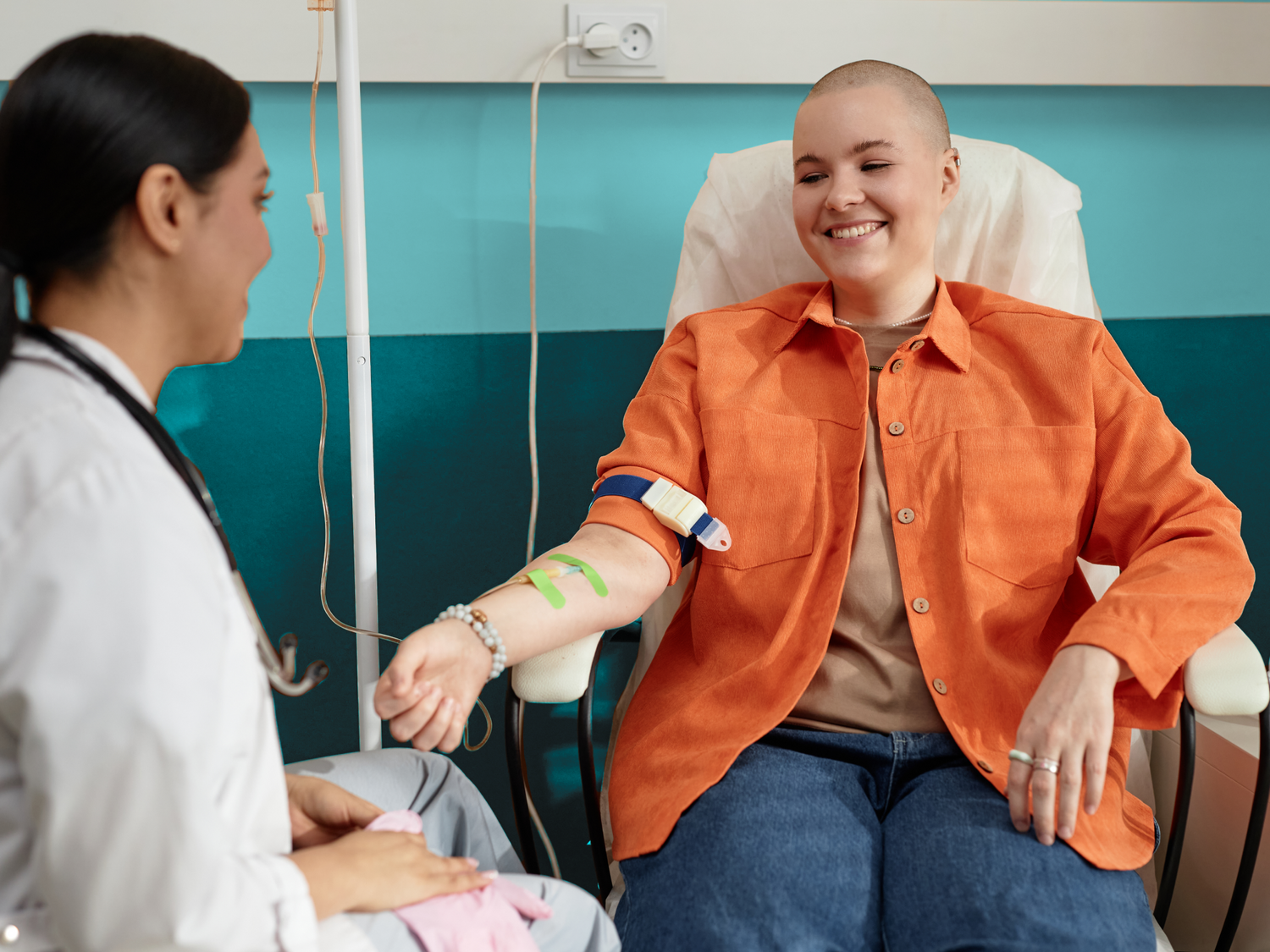Receiving a cancer diagnosis and starting chemotherapy brings many new concerns, and understanding how chemotherapy affects your blood counts is one of the most crucial. Chemotherapy is designed to fight cancer cells aggressively, but this powerful treatment also affects healthy cells in your body, particularly those in your bone marrow that produce your blood cells [1].
Understanding what's happening in your body, what to watch for, and how your medical team will support you through this process can help transform anxiety into empowerment when managing your health during cancer treatment.
How Chemotherapy Affects Blood Cell Production
Chemotherapy medications target rapidly dividing cells—which is exactly what makes cancer cells so dangerous [2]. Unfortunately, your body also has healthy cells that divide quickly, and these become unintended casualties in the fight against cancer.
Your bone marrow, the spongy tissue inside your bones, works like a busy factory producing three essential types of blood cells around the clock. Chemotherapy disrupts this production process, which is why your medical team will monitor your blood counts so closely throughout treatment.
The Complete Blood Count (CBC) test becomes your regular checkpoint, typically scheduled before each treatment cycle and sometimes more frequently [3]. These numbers directly influence your treatment plan. Your oncology team uses your blood count results to determine whether it's safe to proceed with your next chemotherapy session, whether you might need additional support like growth factors or transfusions, and how to adjust your care to keep you as safe as possible.
Common Chemotherapy Types and Their Blood Count Impact
Understanding your specific chemotherapy regimen can help you know what to expect. While every person responds differently, certain patterns emerge with different drug categories.
Alkylating Agents like cyclophosphamide and cisplatin are commonly used for breast cancer. These drugs cause delayed effects—your blood counts might look fine initially, then drop significantly days later, requiring consistent monitoring.
Antimetabolites such as methotrexate and 5-fluorouracil are frequently used for colorectal cancer. These drugs particularly affect your white blood cells, making infection risk the primary concern during treatment.
Anthracyclines like doxorubicin and daunorubicin are powerful drugs used against lymphomas. These medications have cumulative effects—meaning each cycle may have a more pronounced impact on your blood counts.
Taxanes including paclitaxel and docetaxel are frequently used for prostate cancer. With these drugs, neutropenia—a dangerous drop in infection-fighting white blood cells—is often the dose-limiting concern.
Platinum Compounds like carboplatin and oxaliplatin are used for lung cancer. These have a signature effect of thrombocytopenia, or low platelet counts, making bleeding and bruising the primary safety concerns.
The Three Critical Blood Cell Types
Understanding what each type of blood cell does and what happens when counts drop low helps you recognize important symptoms and know when to reach out for help.
Red Blood Cells and Anemia
Your red blood cells carry oxygen from your lungs to every part of your body. When chemotherapy reduces their production, you develop anemia, and you might find yourself exhausted after activities that used to be easy, feeling dizzy when you stand up, or becoming short of breath climbing stairs [1].
This fatigue is bone-deep exhaustion that rest doesn't seem to fix. Your medical team monitors your red blood cell count and hemoglobin levels, and when they drop too low, they may recommend blood transfusions to help restore your energy and oxygen-carrying capacity.
White Blood Cells and Neutropenia
Your white blood cells, particularly neutrophils, are your body's defense against infections. When chemotherapy suppresses these cells, you enter a vulnerable period called neutropenia. This typically occurs 7-14 days after treatment—a timeframe called the nadir, when your counts reach their lowest point.
During neutropenia, your body loses much of its ability to fight off even minor infections. Warning signs include fever (especially 101°F or higher), chills that make you shake, a sore throat, or difficulty breathing [4]. These symptoms require immediate medical attention.
Your healthcare team may prescribe antibiotics as a precaution or give you growth factor injections to help boost your white blood cell production.
Platelets and Thrombocytopenia
Platelets are tiny cell fragments that help your blood clot. When chemotherapy reduces platelet production, you develop thrombocytopenia, and your blood loses its ability to clot effectively.
You might notice that you bruise much more easily than usual, or that small cuts bleed for much longer than they used to [1]. Some patients develop small, red spots on their skin called petechiae, or notice that their gums bleed when brushing teeth. Your medical team monitors your platelet counts closely and can provide platelet transfusions if needed.
Recovery, Monitoring, and Communication
Recovery and Medical Support
Blood count suppression is typically temporary—your bone marrow has remarkable regenerative abilities, with counts usually recovering 2-4 weeks after completing chemotherapy. Your medical team has several tools to support this process.
Growth factor medications like filgrastim (Neupogen) or pegfilgrastim (Neulasta) stimulate white blood cell production, while erythropoiesis-stimulating agents (ESAs) help combat anemia. When counts drop dangerously low, transfusion therapy becomes vital—red blood cell transfusions restore energy and oxygen capacity, while platelet transfusions restore clotting ability.
Your team might also recommend iron supplements, vitamins like B12 and folic acid, or treatment modifications such as dose reductions or cycle delays based on your blood count response.
Monitoring and Safety
Your healthcare team will establish regular monitoring, typically checking blood counts before each treatment cycle [3]. Understanding your results empowers active participation in your care—ask about specific numbers, normal ranges, and intervention thresholds [5].
Critical symptoms requiring immediate contact include fever, chills, unusual fatigue, easy bruising, or prolonged bleeding [4]. Don't hesitate to call outside business hours.
Daily safety measures include meticulous hand hygiene, avoiding crowds during high-risk periods, and food safety precautions. Nutrition also supports recovery—iron-rich foods paired with vitamin C enhance absorption, while adequate protein and hydration support overall healing.
Effective Communication
When reporting symptoms, be specific about timing, severity, and daily life impact. Rather than saying "I feel tired," describe when fatigue is worse and how it affects your activities compared to baseline energy levels.
Ask about target ranges, trend monitoring, and how results influence treatment decisions. Understanding what blood count levels might trigger modifications helps you feel prepared for fluctuations.
Conclusion
Understanding how chemotherapy affects your blood counts empowers you to be an active, informed participant in your cancer care journey. While blood count suppression can feel overwhelming, your healthcare team has extensive experience managing these effects safely.
Regular monitoring, open communication, and awareness of important symptoms allow you to navigate treatment with greater confidence. Your blood counts will fluctuate, and there will be challenging days, but these effects are generally temporary and manageable with proper medical support.
Remember that experiencing these side effects doesn't mean your treatment isn't working—these are expected aspects of cancer therapy. By staying informed and taking an active role in monitoring your health, you're giving yourself the best foundation for successful treatment.
Always consult with your healthcare providers for medical advice, treatment decisions, and any concerns about your specific situation.
References
[1] American Cancer Society. Chemotherapy Side Effects. https://www.cancer.org/cancer/managing-cancer/treatment-types/chemotherapy/chemotherapy-side-effects.html
[2] Cleveland Clinic. Chemotherapy. https://my.clevelandclinic.org/health/treatments/16859-chemotherapy
[3] Cancer Research UK. Chemotherapy Planning - Tests Before Chemotherapy. https://www.cancerresearchuk.org/about-cancer/treatment/chemotherapy/planning/chemotherapy-tests
[4] Cancer Research UK. Your Blood and Bone Marrow - Cancer Drug Side Effects. https://www.cancerresearchuk.org/about-cancer/treatment/cancer-drugs/side-effects/your-blood-and-bone-marrow
[5] American Cancer Society. Understanding Your Lab Test Results. https://www.cancer.org/cancer/diagnosis-staging/tests/understanding-your-lab-test-results.html





Leave a comment
This site is protected by hCaptcha and the hCaptcha Privacy Policy and Terms of Service apply.